THE COMMUNICATION ENVIRONMENT
The issue is this: Do meaningful thought and reason concern merely the manipulation of abstract symbols and their correspondence to an objective reality, independent of any embodiment?
Or do meaningful thought and reason essentially concern the nature of the organism doing the thinking - including the nature of its body, its interactions with its environment, its social character, and so on? Though these are highly abstract questions, there does exist a body of evidence that suggests that the answer to the first question is no and the answer to the second is yes.
- George Lakoff The "fundamental" Shannon/Weaver model of communication focuses on the process by which a messsage sent by one communicator is received by another. However, as this simple situation, which includes only two communicators, is expanded to include additional transmitters and receivers, the sending and receiving of messages becomes very complex
 -- in fact too complex to be fully explained by the Shannon/Weaver
model.
The search for other explanatory models begins with the receiver. Human
beings become informed as they perceive data by means of their senses,
and as they organize this information and give it meaning. The
development of the semiotic model explains this process in terms of signs,
or perceptions that bring to mind concepts about the world. Signs can be
arranged in elaborate systems of codes, including the very complicated
codes that are called languages, and used as a means of communication.
While much communication takes place in one-on-one, or face-to-face,
situations among individual human beings, communication can also take place in
groups, including the very large groups that compose the audiences of the
mass communication media. Thus, no communication is independent of the
social environment within which it occurs. In fact, in social situations it can
be said that one cannot not communicate.
-- in fact too complex to be fully explained by the Shannon/Weaver
model.
The search for other explanatory models begins with the receiver. Human
beings become informed as they perceive data by means of their senses,
and as they organize this information and give it meaning. The
development of the semiotic model explains this process in terms of signs,
or perceptions that bring to mind concepts about the world. Signs can be
arranged in elaborate systems of codes, including the very complicated
codes that are called languages, and used as a means of communication.
While much communication takes place in one-on-one, or face-to-face,
situations among individual human beings, communication can also take place in
groups, including the very large groups that compose the audiences of the
mass communication media. Thus, no communication is independent of the
social environment within which it occurs. In fact, in social situations it can
be said that one cannot not communicate. THE COMMUNICATION ENVIRONMENT
Environments are not passive wrappings, but are, rather, active processes which are invisible.- Marshall McLuhan
Most theories of communication envision communication as a process that occurs by means of messages circulated within a system of interrelated senders and receivers.
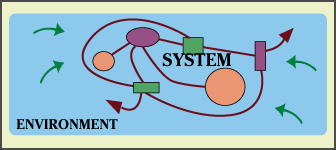
Although scholars typically focus their attention on the system, the environment is also of considerable importance. For one thing, a system cannot survive without its environment. For another, a system's environment is active, and some of that activity necessarily impacts on the system. Communication is carried on by individuals within the context of groups and with the use of signs whose meanings are established in part by negotiation among the members of the groups. Thus, human beings:
- continually create their own signs, and
- they continually encounter and make use of signs created by others.
The Importance of Everyday Life .
COMMUNICATION AND CULTURE
The boundary between society and culture, the two most complex systems on earth, is more difficult to define: at last count there were 164 definitions of culture. The definition that provokes the least disagreement is that culture is what makes societies with the same kind of economic system, the Trobrianders and the Dobu, for instance, or Italy and France, distinct from each other. This implies that culture is symbolic and imaginary, as well as real.
- Anthony Wilden
You may accordingly like to think of culture - I often do - as an enormous pumpkin, hard to penetrate, full of uncharted hollows and recesses for cultural critics to get lost in, and stuffed with seeds of uncertain contents and destiny.
- Jacques Barzun There is general agreement that human communication and human culture are related. There is little agreement as to what that means. Denis McQuail provides a summary definition If we extract different points from these different usages, it seems that culture must have all of the following attributes.
- It is something collective and shared with others;
- It must have some symbolic form of expression, whether intended as such or not;
- It has some pattern, order or regularity, and therefore some evaluative dimensions;
- There is (or has been) a dynamic continuity over time.
- Perhaps the most general and essential attribute of culture is communication, since cultures could not develop, survive, extend and generally succeed without communication.- Denis McQuail
- In the context used here, the term "culture" names the entire collection of human artifacts. This means that culture includes everything that might possibly be considered as "text," and that it therefore is the "what" that students of communication study in order to understand the "how" and "why" of the communication process.
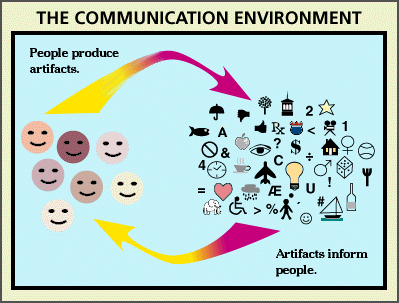
The meaning that one human assigns to a received message is based in part on the meanings that he or she has assigned to other messages in the past, and in part on the meanings that other humans have assigned to similar messages previously exchanged. In this way as individuals and their cultures interact, they are mutually responsible for the construction of the social reality of human life. IDEOLOGY
An ideology is a set of ideas that structure a group's notions of reality, a system of representations or a code of meanings governing how individual and groups see the world.
- Stephen Littlejohn
A group of people who share an ideology share a common set of ideas as to what the world is like. We have already seen that all human groups evolve patterns of behavior - institutions and roles - that become real to them, so it should come as no surprise that a group of people who share an ideology might construct a social reality that fits their beliefs. Those who study ideological behavior point out that most societies have a group of beliefs that the majority of the members of the society share. This is called the dominant ideology of the society. An ideology is a prescription for a way of life. Every society displays a general or 'dominant' ideology: a code of general values most of its people share, consciously and unconsciously, and within which various group and individual ideologies arise.
The task of a general ideology is to explain the past, the present, and the expected future of the system one is in, whether fully, reliably, usable or not. Imaginary ideologies invariably include enough elements of truth to be plausible to most people most of the time, however implausibly these elements may be interpreted and arranged.
- Wilden 91 In terms of the Berger-Luckmann model of the social construction of reality, ideologies serve to legitimize a society's institutions. Americans, for example, have an ideological belief in their right to "throw out" the current government should such action become necessary. This belief helps legitimize the institution we call the "press," which has as one of its functions the task of keeping a close watch on the government and telling everyone "what is going on." In our schools we contribute to this legitimation by teaching about situations such as the Watergate Hearings in which the press played a major role in bringing government impropriety to light. Ideologies are by nature symbolic: what they symbolize may be both imaginary and real, reality being the ultimate test of their validity. They are transmitted between people by every available means: ritual, schooling, clothing, religion, jokes, games, myths, gestures, ornaments, entertainment.
- Wilden 91 Because ideologies are so closely tied to reality, and because they are concepts, they form an important part of our communication environment. As with institutions, they manifest themselves as rules, but whereas institutions constrain our behavior and actions, ideologies constrain our thoughts and speech. DEFINING IDEOLOGYThere is considerable dispute as to the precise definition of the term "ideology." The definition we will introduce here is proposed by L. B. Brown and will serve us as a framework within which we will explore the relationship between ideology and communication. Brown suggests that all ideologies have the following characteristics.
- An ideology gives answers to important questions and defines approaches to them.
- An ideology involves commitment to a recognized position.
- Ideologies are concepts.
- The response to ideologies is therefore personal although their basis is social.
- An ideology about other ideologies itself becomes a structure to which
people can cling to interpret behaviour so it screens out and simplifies the
possible patterns of response.
- Brown173
Taken together, these characteristics define an environment that operates as a set of rules, that is, ideologies act as constraints on the behavior of the social system. By encouraging certain expressions and discouraging others, and because they act at the level of concepts, ideologies put constraints on communication. Brown's criteria will be examined in detail next.
AN IDEOLOGY GIVES ANSWERS TO IMPORTANT QUESTIONS AND DEFINES APPROACHES TO THEM"Who am I? Why am I here? What should we do, and how should we do it?" Ideologies provide answers to these, and similiar kinds of important questions. For example, a society that shares an ideological belief that people should help their neighbors will turn out immediately to give assistance in the face of a natural disaster. The question, "what shall we do?" need not be discussed because the answer is obvious by means of the shared belief.
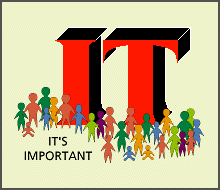 Members of an
ideology may hold beliefs that members of different ideologies others find
silly, inconvenient, or even hateful. However, to the member of the ideology
these beliefs are part of reality, and are therefore, by definition, true.
The theory of the social construction of reality argues that roles develop
within institutions. One of the things that makes ideologies powerful is that by
giving answers to important questions, they help define these institutional
roles. Thus, within a society with an unchallenged dominant ideology "everybody
knows their place" and there is no need to question rules or roles.
However, most societies contain a mix of ideologies. These are often
catagorized into three types: dominant, subordinate and radical.
Members of an
ideology may hold beliefs that members of different ideologies others find
silly, inconvenient, or even hateful. However, to the member of the ideology
these beliefs are part of reality, and are therefore, by definition, true.
The theory of the social construction of reality argues that roles develop
within institutions. One of the things that makes ideologies powerful is that by
giving answers to important questions, they help define these institutional
roles. Thus, within a society with an unchallenged dominant ideology "everybody
knows their place" and there is no need to question rules or roles.
However, most societies contain a mix of ideologies. These are often
catagorized into three types: dominant, subordinate and radical.
- The dominant ideology in a society is the one which is held by most of the people and defines what is "normal" and "right." For example, in our society it is considered normal for people to wear clothes in public places. When we see a person with clothes on, it seems "right" to us, and we give it no further thought.
- A subordinate ideology is a set of ideas that agree with the dominant ideology in the main, but which argues for a limited amount of change. For example, in our society some people argue that it should be all right for both men and women to go topless on public beaches. This position does not attempt to overthrow the normal ideology of wearing clothes, but it cites a special circumstance (the beach as a very informal place where very little clothing is required), and a need to be fair (if men may go topless, than women should, too).
- A radical ideology is a set of ideas that is in direct opposition to the dominant ideology. In this case the argument that nudity should be an option for anyone at anytime is a radical argument. It sets out to replace the dominant ideology with a new one. Over time, radical ideologies can grow to dominate, and dominant ideologies can dissolve and disappear. AN IDEOLOGY INVOLVES COMMITMENT TO A RECOGNIZED POSITION
 For example, the
wars of the Protestant Reformation in Europe were fought between two strongly
ideological groups, the Protestant Christians and the Roman Catholic Christians.
Although the two groups shared many beliefs and customs, they took opposing
positions on certain concepts, and when these two groups with their different
realities tried to share the same space, the result was a bloody and devastating
war.
This aspect of ideology is especially visible in mass communication.
Newspapers and magazines which are owned by individuals or groups who subscribe
to a particular ideology often adjust the content of their messages accordingly.
The same news event may be described very differently in a "liberal" as opposed
to a "conservative" newspaper. Or some television stations may put restrictions
on the types of shows that they will allow on the air. Campaigns to remove
"sex," "violence," "drugs," "crime" and other themes from the mass media, or to
add themes relating to various races, classes and genders are examples of action
based on ideological commitment. Patriarchy
IDEOLOGIES ARE CONCEPTSIdeologies occur in the mind. To this extent
they are "imaginary," but concepts can contribute powerfully to the reality in
which we live. Consider, for example, the two strongly oppositional positions
taken in the
For example, the
wars of the Protestant Reformation in Europe were fought between two strongly
ideological groups, the Protestant Christians and the Roman Catholic Christians.
Although the two groups shared many beliefs and customs, they took opposing
positions on certain concepts, and when these two groups with their different
realities tried to share the same space, the result was a bloody and devastating
war.
This aspect of ideology is especially visible in mass communication.
Newspapers and magazines which are owned by individuals or groups who subscribe
to a particular ideology often adjust the content of their messages accordingly.
The same news event may be described very differently in a "liberal" as opposed
to a "conservative" newspaper. Or some television stations may put restrictions
on the types of shows that they will allow on the air. Campaigns to remove
"sex," "violence," "drugs," "crime" and other themes from the mass media, or to
add themes relating to various races, classes and genders are examples of action
based on ideological commitment. Patriarchy
IDEOLOGIES ARE CONCEPTSIdeologies occur in the mind. To this extent
they are "imaginary," but concepts can contribute powerfully to the reality in
which we live. Consider, for example, the two strongly oppositional positions
taken in the 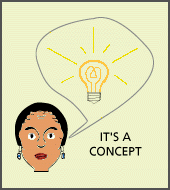 current debate on
abortion in the United States. One side argues in favor of the idea that it is
wrong for one human being to kill another, and one side argues in favor of the
idea that it is wrong for the government to interfere in the personal lives of
its citizens.
current debate on
abortion in the United States. One side argues in favor of the idea that it is
wrong for one human being to kill another, and one side argues in favor of the
idea that it is wrong for the government to interfere in the personal lives of
its citizens.
The legal institutions of the United States have grown from the Declaration of Independence and the Constitution. These institutions promise "life, liberty and the pursuit of happiness." In the abortion debate one group argues for liberty; the other for life. Thus, both of these groups represent dominant ideologies in U.S. society. In this particular situation these two ideologies are in conflict, and this produces the great argument on the subject. "Life" and "liberty" are concepts -- which is to say that no uniformly accepted, exact definition of either exists. Thus, these two ideologies assert different social realities, and this is one of the reasons why the debate seems to continue endlessly without resolution. Patriarchy
THE RESPONSE TO IDEOLOGIES IS THEREFORE PERSONAL ALTHOUGH THEIR BASIS IS SOCIAL
An ideology is a set of shared concepts that draws its meaning in part from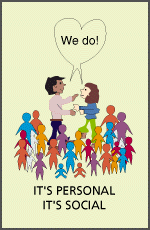 the group. But
ideologies manifest themselves in the actions of individuals.
the group. But
ideologies manifest themselves in the actions of individuals.
In terms of the "abortion" example introduced above, women who have abortions are acting personally, as are the people who sit on the street in front of health care centers that perform abortions, as are the lawyers who donate their time to litigate court cases that apply to abortion, and so on. An ideology, therefore, is not something abstract, such as "the government in Washington," or "the economy," or "the educational system." Ideology occurs within people's own minds and affects their day-to-day lives. And, as it is the habits that people develop in their day-to-day living that eventually become a society's reified institutions and roles, ideologies thus play a significant part in the social construction of reality. Patriarchy AN IDEOLOGY ABOUT OTHER IDEOLOGIES ITSELF BECOMES A STRUCTURE TO WHICH PEOPLE CAN CLING TO INTERPRET SO IT SCREENS OUT AND SIMPLIFIES THE POSSIBLE PATTERNS OF RESPONSESo, how do you feel about Socialists? --about Environmentalists? --about Christians? --about Jews? --Buddhists? --Republicans? --Democrats? --Feminists? --Nudists? --Meat-eaters? --Vegetarians? --Blacks? --Whites? --Hispanics? --Gays? --Lesbians? --People who watch daytime talk shows? --People who drive expensive cars?
An ideology is a social phenomenon - that is, it is a collection of beliefs that are shared by the members of a group. When one group shares a set of ideas about the ideology of another group, that is, a belief about a set of beliefs, stereotypes may develop.
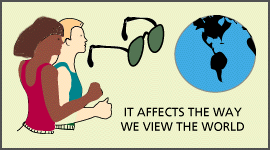
Unfortunately, when people stereotype ideologies of which they are ignorant, they often focus on the most negative characteristics. Nonetheless, stereotypes are not always bad. In fact they are closely related to the roles that are associates with social institutions, and they play an important part in the social construction of reality. In general, it is useful to stereotype police officers as being honest, fire fighters as being courageous, mail carriers as being dedicated, and so on because these stereotypes allow us to predict the behavior of others as we "make sense" of the social world in which we live. Once we have stereotyped a person or group, however, we usually find it difficult to treat them as "regular" individuals